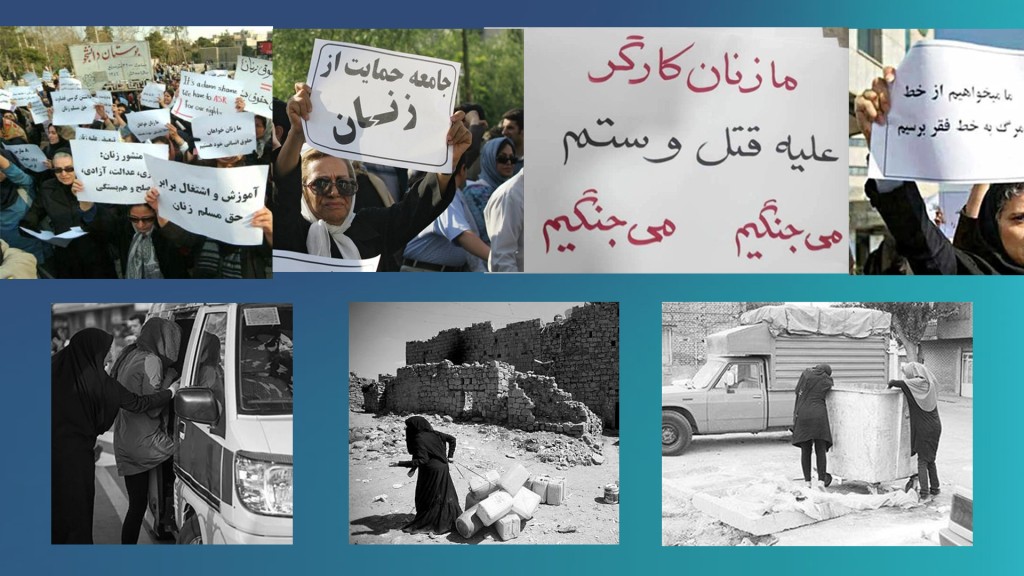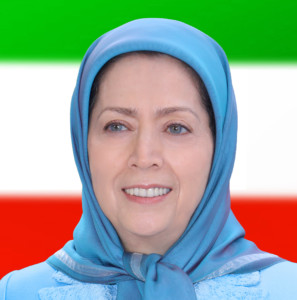Iran’s Hidden Budget: No Funds for Women’s Welfare

How much does the Iranian government spend annually?
What are the costs of healthcare, education, welfare, infrastructure, transportation, communication, services, war, and security? How much of this budget is spent on supporting and empowering women?
No one can answer this question because a large portion of the regime’s expenses is hidden. These costs fall into two parts:
The larger portion is spent by the Supreme Leader and the IRGC. Their source comes from the income of multiple very wealthy foundations (such as the Execution of Imam Khomeini Order (EIKO)) that have been created over the past 40 years through the expropriation of public assets. A report on this wealth is provided in the following book: The Rise of the Revolutionary Guards’ Financial Empire, National Council of Resistance of Iran – U.S. Representative Office, 2017.
Another source for the Supreme Leader’s funds is the quota he receives annually from the export of Iran’s oil. The amount of this quota is also one of the economic secrets of current Iran.
On December 18, 2024, Reuters reported: “Six experts—including Western officials, security analysts, and Iranian and commercial sources—stated that the Islamic Revolutionary Guard Corps (IRGC) now controls up to 50% of Iran’s oil exports, a significant increase from about 20% three years ago.”[1]
Military and security spending dominates the public budget
The smaller portion of the expenses is managed by the government, as outlined in the annual budget law. What the United Nations, the World Bank, the IMF, and other international specialized institutions publish about Iran’s social or military expenditures relies on reports from the Central Bank, the Statistics Organization, or other governmental institutions in Iran, all of which are part of this second portion.
A review of the current year’s budget law (March 2024-March 2025, Iranian year 1403) shows that 32.1% of expenses go toward military and security matters. This includes the costs of the IRGC, the army, the Basij, the State Security Force, the Ministry of Defense, etc.[2]
Where does the money really go?
The “Imam Khomeini Relief Committee” has a budget allocation of more than 18.5 trillion tomans in this law, equivalent to 580 million euros. This committee presents itself as a charity organization aiming to help the poor and female-headed households. A small part of this claim is true.
In Iran, there are about 5 million female-headed households,[3] and the Relief Committee provides small assistance to 1.2 million of them.[4]
The committee does not assist the other 3.8 million female-headed households because it has another mission: construction projects in Syria and Lebanon and financial and welfare support for the regime’s proxy fighters in those countries.
According to a Eurasia Foundation report, between 2012 and 2022, about two billion dollars were spent on the restoration and maintenance of Shia religious sites in Syria by the Relief Committee and the Khatam al-Anbiya Construction Headquarters.
Another entity receiving funds from the government’s annual budget is the “Islamic Revolution Housing Foundation.” This foundation claims its goal is to build affordable housing for the poor. However, it is actually one of the institutions supporting the regime’s war efforts in Syria and Lebanon. The Central Bank of Syria reports that between 2016 and 2021, the Islamic Revolution Housing Foundation spent up to 1.5 billion dollars on rebuilding residential areas in Aleppo.[5]
The dictatorial regime of Bashar Assad that was toppled in December 2024 imposed a heavy burden on Iran’s budget.
The U.S. Congressional Research Office and the Stockholm International Peace Research Institute (SIPRI) report that since the start of the Syrian civil war in 2011 until 2023, the Islamic Republic has spent between 30 to 35 billion dollars on military and logistical infrastructure, training Syrian forces, and deploying military advisors in Syria.[6]
In addition to the above sum, between 2011 and 2021, the Iranian regime contributed 50 billion dollars in cash or cheap oil shipments to the dictatorship of Bashar al-Assad. This amount is listed in an internal Ministry of Foreign Affairs document.[7]
What about healthcare, education, and welfare?
Little budget is allocated to healthcare, education, welfare, or infrastructure.
Nurses, teachers, retirees, workers, etc., are constantly protesting and striking due to poverty and inflation.
Government spokespeople explain that the reason for this lack of funding is that international sanctions have reduced Iran’s revenue. It is true that in recent years, Western governments, including the European Union and the U.S., have repeatedly issued notices regarding sanctions on Iranian individuals and entities. However, these sanctions have mostly been symbolic and have not gone beyond listing names on blacklists. As a result, they have not impacted Iran’s financial turnover, foreign trade, or oil and gas exports in any significant way.
The Financial Times quotes the U.S. Treasury Secretary as saying, “Iran is clearly continuing its oil exports.” Armen Azizian, a senior analyst and sanctions expert at Vertex, states: “The impact of sanctions on Iran’s oil exports has so far been minimal.”[8]
According to Reuters, “The U.S. Energy Information Administration (EIA) estimated that Iran’s oil export revenues were approximately $54 billion in 2022 and $53 billion in 2023.”[9]
What is the real economic status of women in Iran?
According to the latest official census (2016), the population of women in Iran is 39.4 million.
Of this population, 27.6 million are of working age (15 to 64 years old). However, the number of employed women is only 3.9 million.[10]
Therefore, 23.7 million working-age women in Iran do not have jobs. In a country where 80% of the population has fallen below the poverty line, the deprivation and lack of social support have affected women far more than men.
It is true that in recent years, the government has put programs in place to support women. These programs have two characteristics: First, they are deeply political and ideological, and they only cover a limited segment of the female population.
Second, only a small portion of these programs are implemented, and they mostly remain on paper.
Are government programs for women effective?
According to the Supreme Leader’s orders, the government is obligated to increase the country’s population. To achieve this goal, various government directives have been issued. The most significant of these are the “General Population Policies” issued by Khamenei on May 2, 2011, and the “General Family Policies” issued by him on September 3, 2016, particularly the “Law on Family and Population Youth Support.”[11]
The fertility rate in the Iranian year 1400 (2021) dropped to 1.7. Khamenei is trying to raise this rate to increase Iran’s population to 150 million.
According to the new law, the government is required to support childbirth by offering facilities such as land, housing, vehicles, factory shares, health insurance for pregnant women, social insurance for mothers with three or more children, and loans.
In a country where the average family size is 3.3, and families do not want more than one or two children, the regime’s laws (if ever implemented beyond paper) would only affect a limited segment of women.
This program is essentially a project to deprive most women in Iran of social support. However, further investigations reveal that the promised benefits in these laws have only been partially implemented.
For example, one of the key issues in government advertisements is insurance for women. However, this insurance is actually “social insurance for mothers with three or more children, specifically in rural and nomadic areas.”
That means a woman must have more than three children and live in a village. These mothers total only 2.2 million in Iran. Since the law’s implementation, the regime has only kept its promise for about 300,000 of them.[12] But even this hollow insurance was stopped in 2024.
The government’s budget bill for the coming Iranian year decided to halt “social insurance for mothers with three or more children in rural and nomadic areas.” [13]
The Gap Between Official Claims and Social Reality
Another issue that sometimes appears in government advertisements is the claim that the Welfare Organization is supporting Iranian women. However, of the approximately 5 million female-headed households, many of whom are poor and disadvantaged,[14] the Welfare Organization only covers 287,000 households.[15]
[1] https://www.reuters.com/world/middle-east/irans-revolutionary-guards-extend-control-over-tehrans-oil-exports-sources-say-2024-12-18
[2] 1403 National Budget Law, https://shenasname.ir/?p=59967
[3] Mohammad Baqer Ghalibaf, speaker of the parliament, ISNA state-run news agency, January 25, 2022, isna.ir/xdKWLW
[4] Hossein Kheder Veisi, vice president of the Relief Committee, Mehr news agency, June 15, 2023, mehrnews.com/x32qdb
[5] Radio Farda, December 16, 2024, https://www.radiofarda.com/a/assad-fallout-iran-economy/33240712.html
[6] Ibid.
[7] This document was first published in 2023, by Ghiam-ta-Sarnegooni Telegram Channel, which usually exposes the Iranian regime’s internal documents.
[8] The Financial Times, April 18, 2018
[9] Reuters, December 18, 2024
[10] Islamic Republic News Agency (IRNA), April 11, 2020, www.irna.ir/xjxQKG
[11] Law on Family and Population Youth Support, ordered on November 28, 2020, https://shenasname.ir/?p=7640
[12] Research Center of the Parliament, expert evaluation of the rulings in amendment 13 of Social Support, page 21
[13] Budget Bill of Iranian Year 1404 (2025)
[14] According to the Atlas on the conditions of Female Heads of Household, half of the population of female heads of household are illiterate… Most of them are either unemployed or have part-time, informal jobs with low payment. Fatemeh Torabi and others on the “Vulnerability of Female Heads of Households and the arguments on policy-making for it in Iran,” Examining Social Issues Magazine, 2022, Vol. 13, www.irna.ir/xjMFHQ
[15] Narjes As’adi, director general of the Office of Empowerment of Families and Women in the Welfare Organization, website of the Welfare Organization, January 14, 2020, https://behzisti.ir/xRxW
- Tags: Human Rights, mullahs' regime, people of Iran, Women

